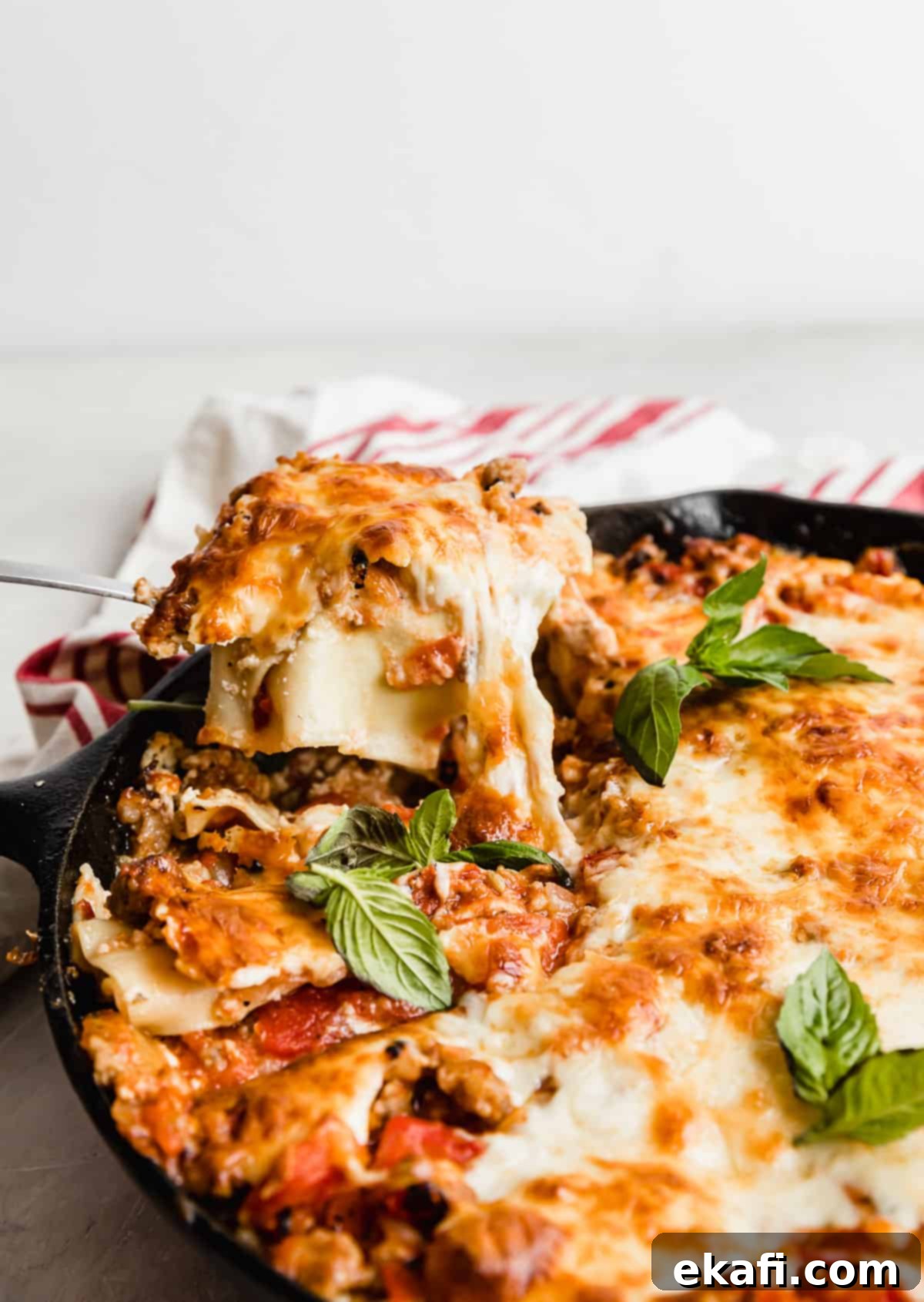Ultimate Cast Iron Lasagna: Easy, Flavorful & No-Boil Skillet Recipe
Prepare to elevate your comfort food game with the most exquisite cast iron lasagna recipe! This dish is a true symphony of flavors, featuring a rich, savory Italian sausage and tomato ragu, complemented by a luxuriously creamy herbed ricotta filling. What makes this recipe truly revolutionary is its use of no-boil lasagna noodles, transforming a typically time-consuming meal into a surprisingly hassle-free culinary delight. Get ready for layers of pure comfort, all baked to perfection in a single, versatile skillet.
Lasagna holds a special place in the hearts of comfort food enthusiasts, and for good reason! Its hearty layers and comforting warmth make it a perennial favorite. If you adore classic lasagna, you’ll love exploring its delicious variations. Be sure to try our slow cooker lasagna for set-it-and-forget-it ease, our innovative lasagna soup for a cozy twist, or embark on a culinary adventure with our vibrant Mexican lasagna. Each offers a unique spin on this beloved classic, but none capture the rustic charm and simple elegance quite like this cast iron version.
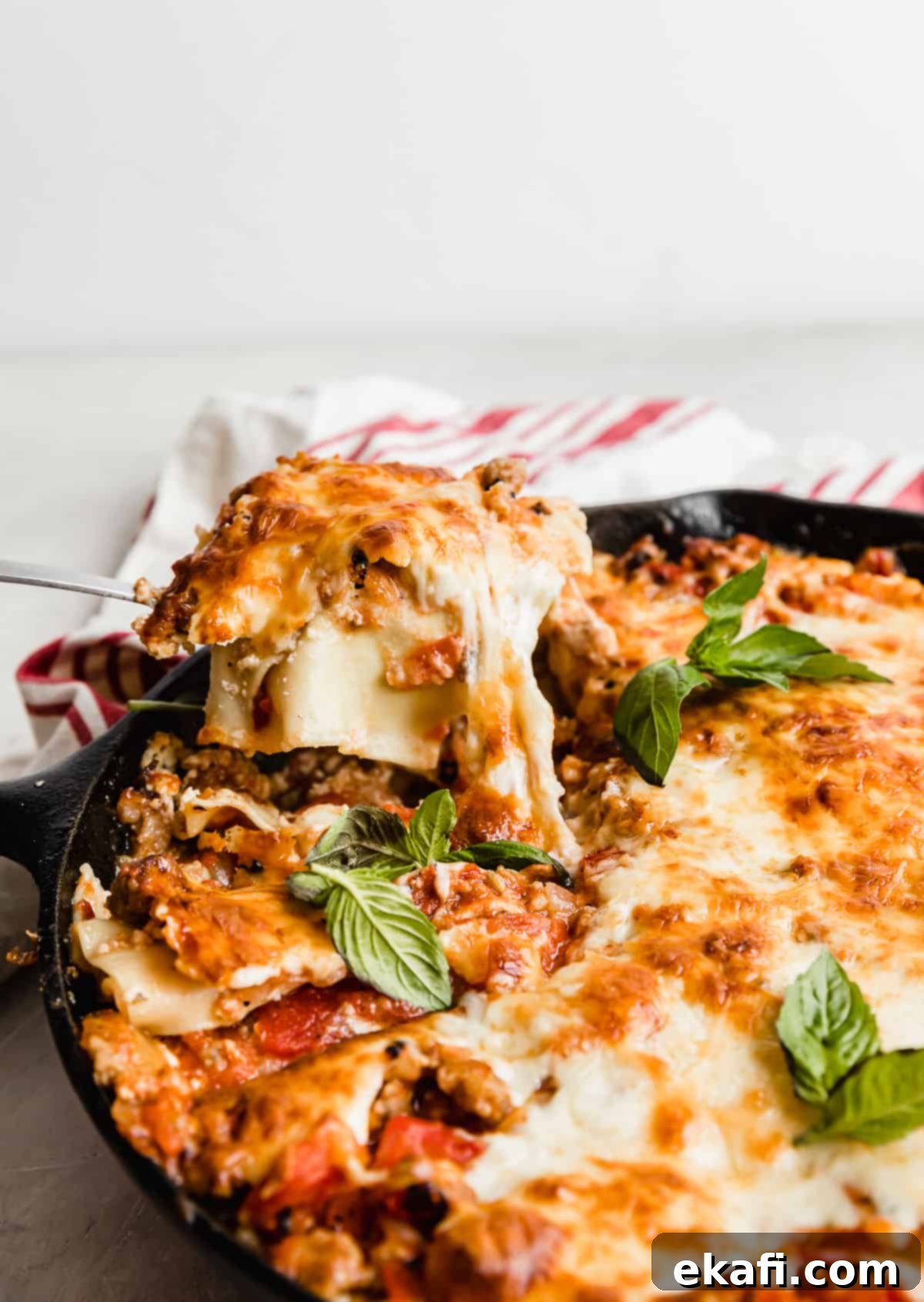
Why This Cast Iron Lasagna Recipe is a Game-Changer
This isn’t just another lasagna recipe; it’s a culinary triumph designed for maximum flavor and minimal fuss. Here’s why this particular cast iron skillet lasagna stands out and will quickly become a favorite in your kitchen:
- Effortless No-Boil Lasagna Noodles: The biggest time-saver and perhaps the most brilliant aspect of this recipe is the use of no-boil lasagna noodles. Forget the messy, extra step of pre-cooking noodles in boiling water. These specially prepared noodles are designed to soften and cook directly in the sauce, absorbing all those incredible flavors as they bake. This means less cleanup, less active cooking time, and a much smoother layering process – a huge win for busy home cooks who crave authentic, homemade lasagna without the usual culinary commitment.
- A Symphony of Flavors: I’ve had my share of homemade lasagna over the years, and this one truly takes the crown. Every element contributes to an unforgettable flavor profile. The meat ragu is crafted with savory Italian sausage, which infuses the entire sauce with a depth and richness far beyond what plain ground beef can offer. The fire-roasted diced tomatoes add a subtle, yet distinct smoky undertone, creating a more complex and inviting sauce. And then there’s the herbed ricotta mixture – oh, the herbed ricotta! Lightly seasoned with fragrant oregano and thyme, it’s so creamy and delicious, you might be tempted to eat it straight from the bowl! This blend of savory, smoky, and creamy layers creates an unparalleled taste experience.
- Convenience of a Skillet Recipe: There’s something undeniably satisfying about preparing a hearty meal in a single pan. This lasagna is made entirely in a cast iron skillet, which not only simplifies the cooking and cleanup process but also adds a rustic charm to your presentation. Cast iron excels at even heat distribution and retention, ensuring your lasagna cooks beautifully from edge to center and develops a perfectly golden, bubbly top. The skillet I use, linked here, is not only fantastic but also surprisingly affordable, making it a great investment for any kitchen.
Essential Ingredient Notes for Your Skillet Lasagna
Understanding your ingredients is key to mastering any recipe. Here’s a closer look at the stars of our Cast Iron Lasagna, with tips to ensure the best possible outcome:
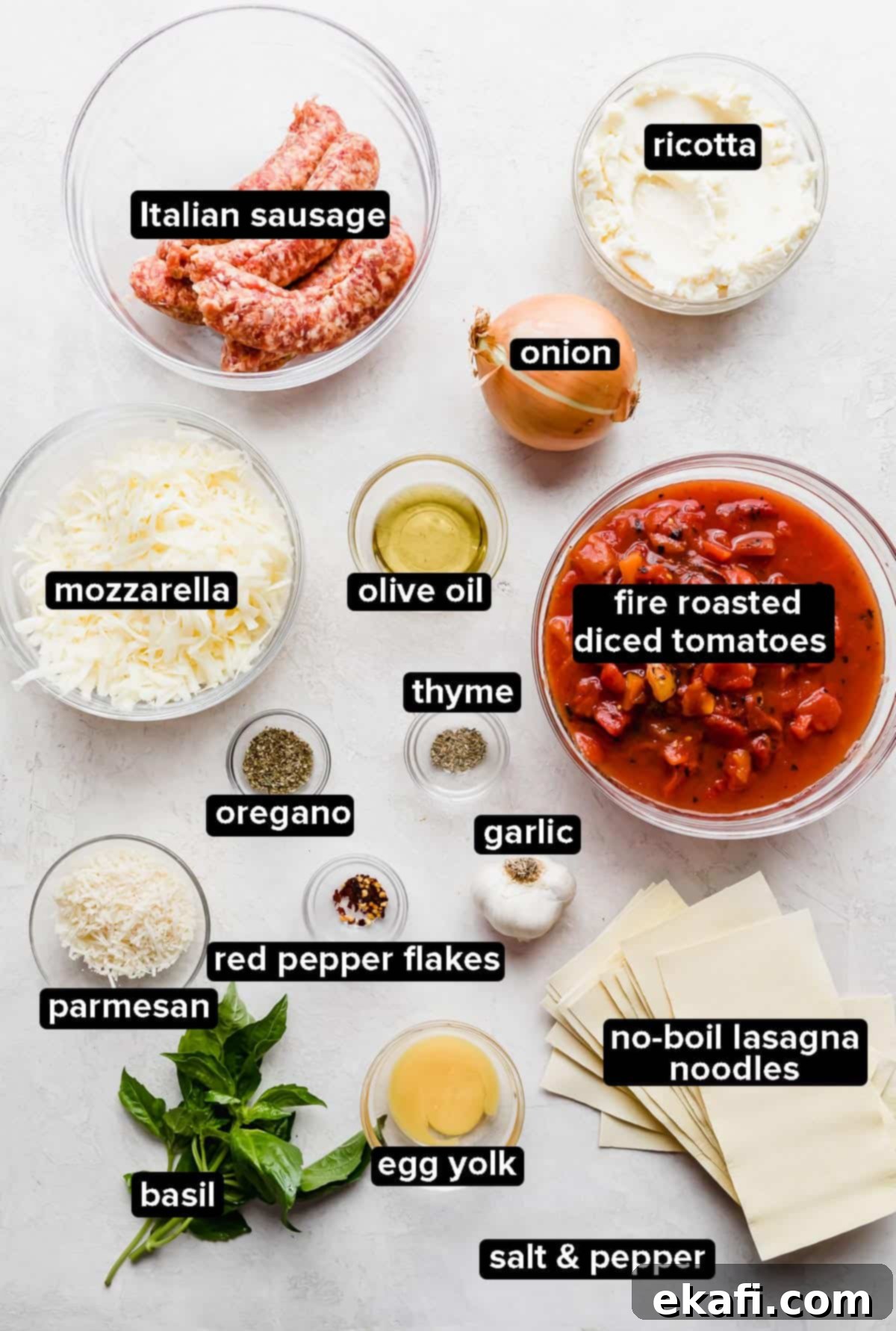
- No-Boil Lasagna Noodles: These innovative noodles are a true game-changer for easy lasagna. Unlike traditional noodles that require pre-boiling, these have been par-cooked and then dehydrated, making them thinner and faster to absorb moisture. This means they cook directly in the moisture from your ragu and ricotta, softening beautifully and infusing with flavor as the lasagna bakes. This eliminates a significant step, saving you time and effort while still achieving that perfect al dente texture.
- Fire-Roasted Diced Tomatoes: Don’t let the “fire-roasted” name intimidate you; these aren’t inherently spicy. Instead, they offer a rich, smoky depth of flavor that ordinary diced tomatoes simply can’t match. The roasting process caramelizes their natural sugars and adds a beautiful complexity, making your ragu more vibrant and robust. If you can’t find fire-roasted, regular diced tomatoes will work, but you might miss that subtle smoky note.
- Ricotta Cheese: Hailing from Italy, “ricotta” literally means “recooked,” referring to the method of making this creamy, soft cheese from the whey leftover from other cheese production (like mozzarella or provolone), often from cow, goat, sheep, or buffalo milk. In lasagna, ricotta provides an essential creamy layer, offering a delicate tang and balancing the richness of the meat sauce. Its soft, granular texture also adds a wonderful mouthfeel to the dish.
- Italian Sausage: For this recipe, I’ve opted for a classic sweet Italian sausage, which brings a wonderful balance of savory pork and aromatic fennel and other mild spices to the ragu. This choice significantly boosts the overall flavor of your cast iron lasagna. However, if you’re a fan of heat and want to kick things up a notch, feel free to substitute with hot Italian sausage. The spices in the hot version will add a pleasant warmth without being overwhelming.
Step-by-Step Guide to Your Perfect Cast Iron Lasagna
Follow these simple instructions to assemble your incredibly delicious and easy cast iron skillet lasagna. The beauty of this recipe lies in its straightforward layering and no-boil noodles!
- Prepare the Flavorful Lasagna Ragu. Begin by placing your 12-inch cast iron skillet over medium heat and adding the olive oil. Once the oil shimmers, add the finely chopped yellow onion and cook until it’s softened and lightly browned, typically 6-7 minutes. Next, stir in the minced garlic and red pepper flakes, cooking for just about 30 seconds until fragrant. Add the sweet Italian sausage (casings removed) to the skillet, using a wooden spoon to break it up into small, bite-sized pieces as it cooks. Continue to cook until the sausage is thoroughly browned and no longer pink, about 6 minutes. Finally, stir in the fire-roasted diced tomatoes and a small amount of water (if the sauce seems too thick, a splash of water helps prevent it from drying out). Allow the mixture to simmer gently for about 8 minutes on medium-low heat, letting the flavors meld. Once done, transfer this rich ragu to a separate bowl, leaving the skillet ready for assembly.
- Craft the Creamy Herbed Ricotta Mixture. In a clean medium-sized bowl, combine the ricotta cheese, a single egg yolk (which helps bind the mixture and adds richness), dried oregano, dried thyme, and season generously with salt and pepper to taste. Stir all the ingredients together thoroughly until they are well combined and the mixture is smooth and uniform. This herbed ricotta layer is crucial for the lasagna’s creamy texture and aromatic depth.
- Combine the Cheeses. In a third bowl, mix the shredded mozzarella cheese and freshly grated Parmesan cheese. This blend will provide that irresistible gooey, golden-brown topping and cheesy layers throughout your lasagna. Set aside.
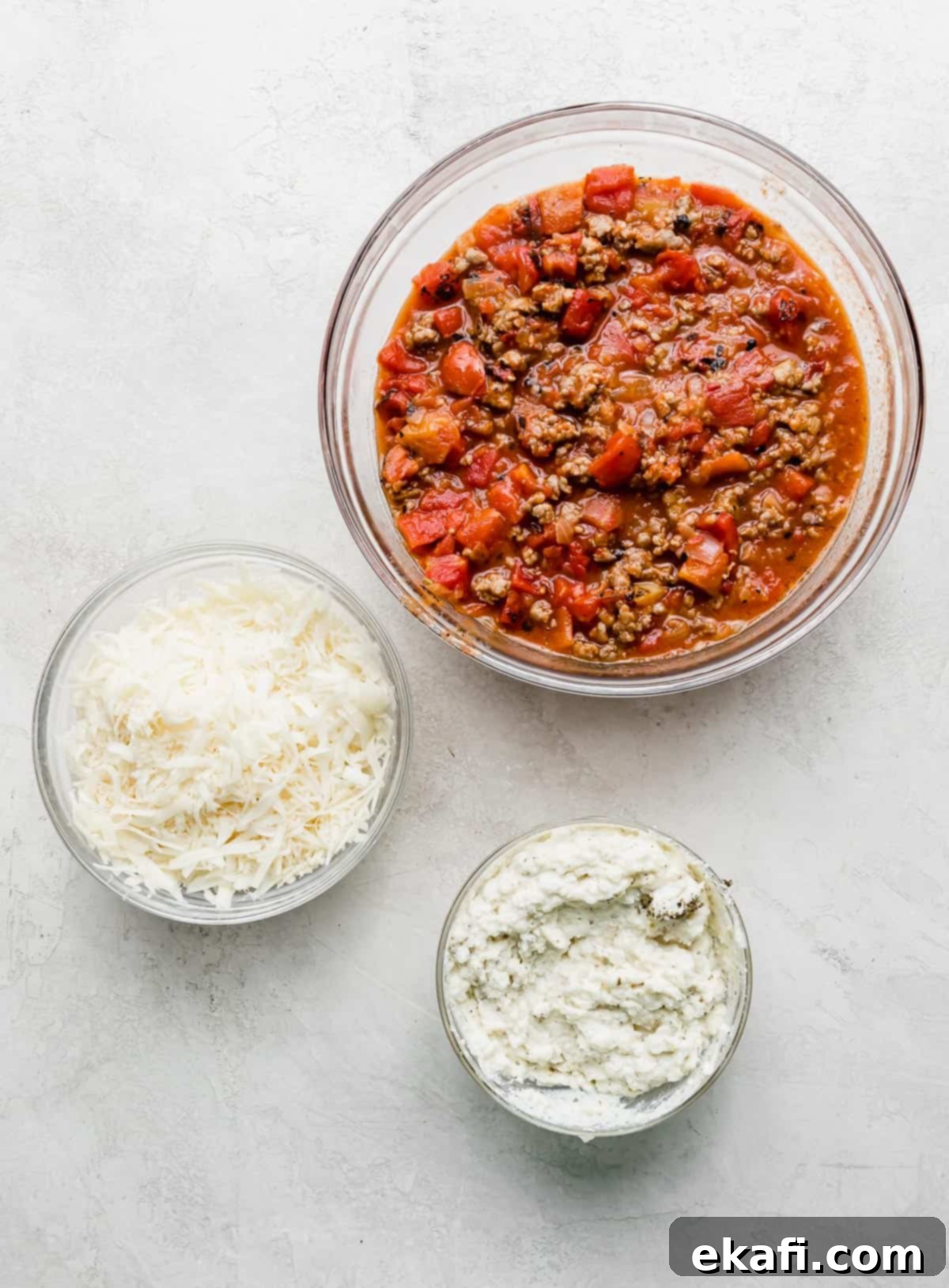
- Assemble the Cast Iron Skillet Lasagna. Now for the fun part: layering! Spread approximately 1 cup of your delicious sausage and tomato ragu evenly across the bottom of the empty cast iron skillet. This forms the foundational layer and helps prevent the noodles from sticking. Next, take your no-boil lasagna noodles (which you’ve broken in half for easier layering in the round skillet) and arrange 7 of these halves along the perimeter of the skillet, overlapping them slightly if necessary, and place one half in the middle to cover any gaps. Over this noodle layer, carefully spread 1/3 of the herbed ricotta mixture, ensuring it’s evenly distributed. Then, sprinkle about a quarter of the mozzarella and Parmesan cheese blend over the ricotta. Finally, add 1/3 of the remaining meat sauce over the cheese layer.
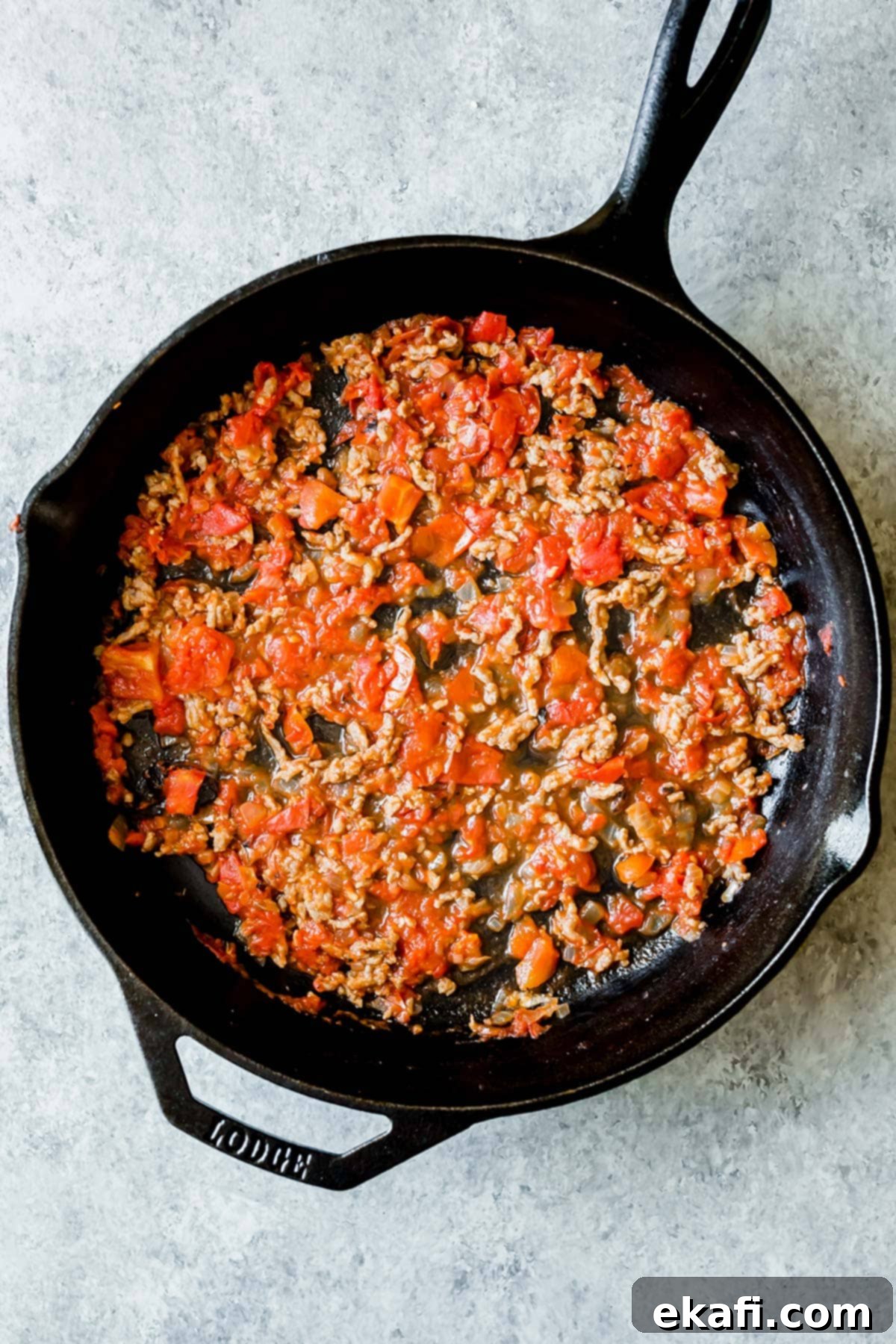
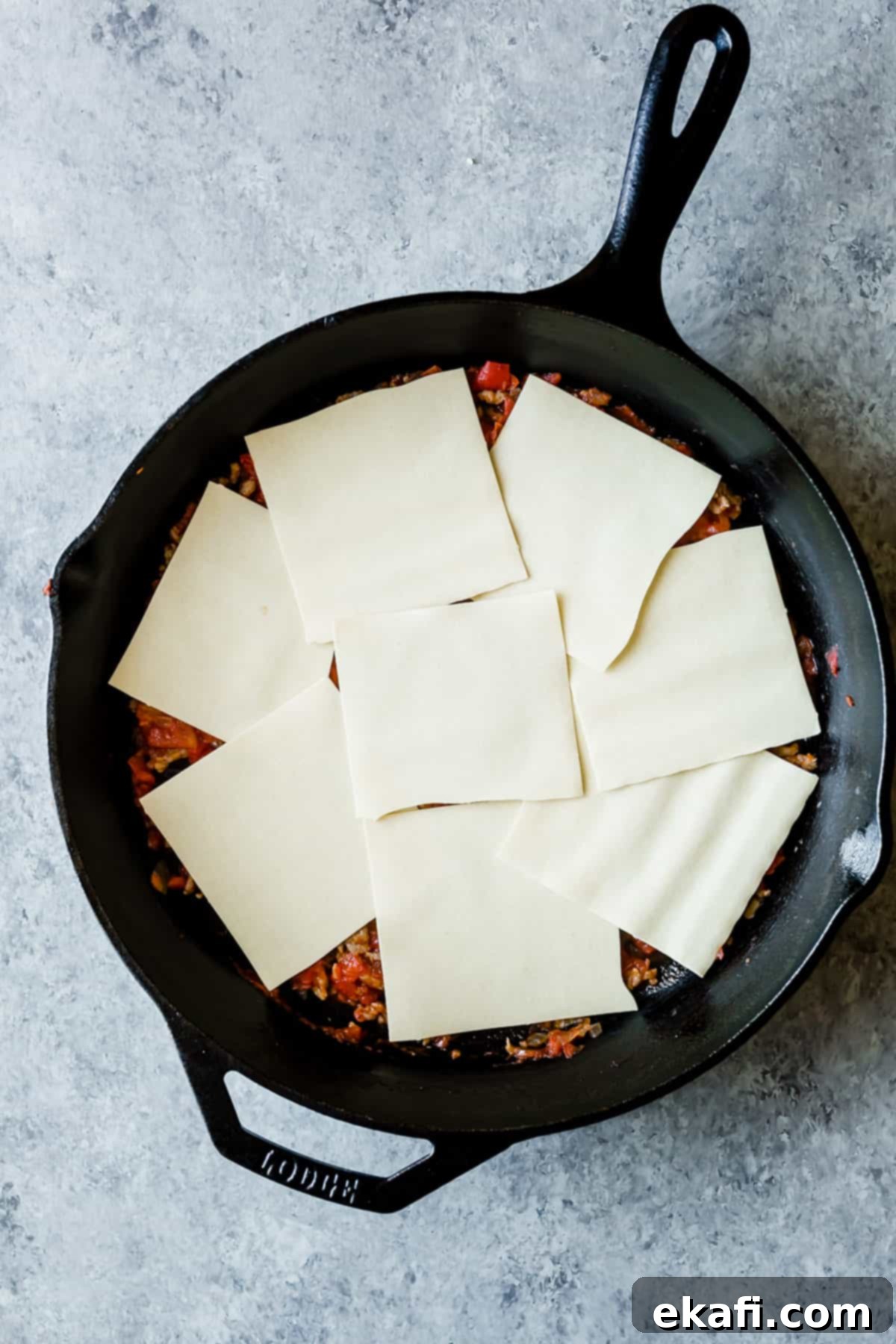
- Continue Layering for Richness. Repeat the layering process from Step 4 two more times. Each repeat should start with a layer of broken no-boil noodles, followed by 1/3 of the remaining ricotta mixture, then a quarter of the cheese blend, and finally 1/3 of the remaining meat sauce. For the very top layer, after the final sauce application, sprinkle the remaining mozzarella and Parmesan cheese mixture generously over everything. This ensures a beautiful, bubbly, golden-brown crust when baked. (Refer to the blog post pictures for a visual guide to ensure perfect layering!).
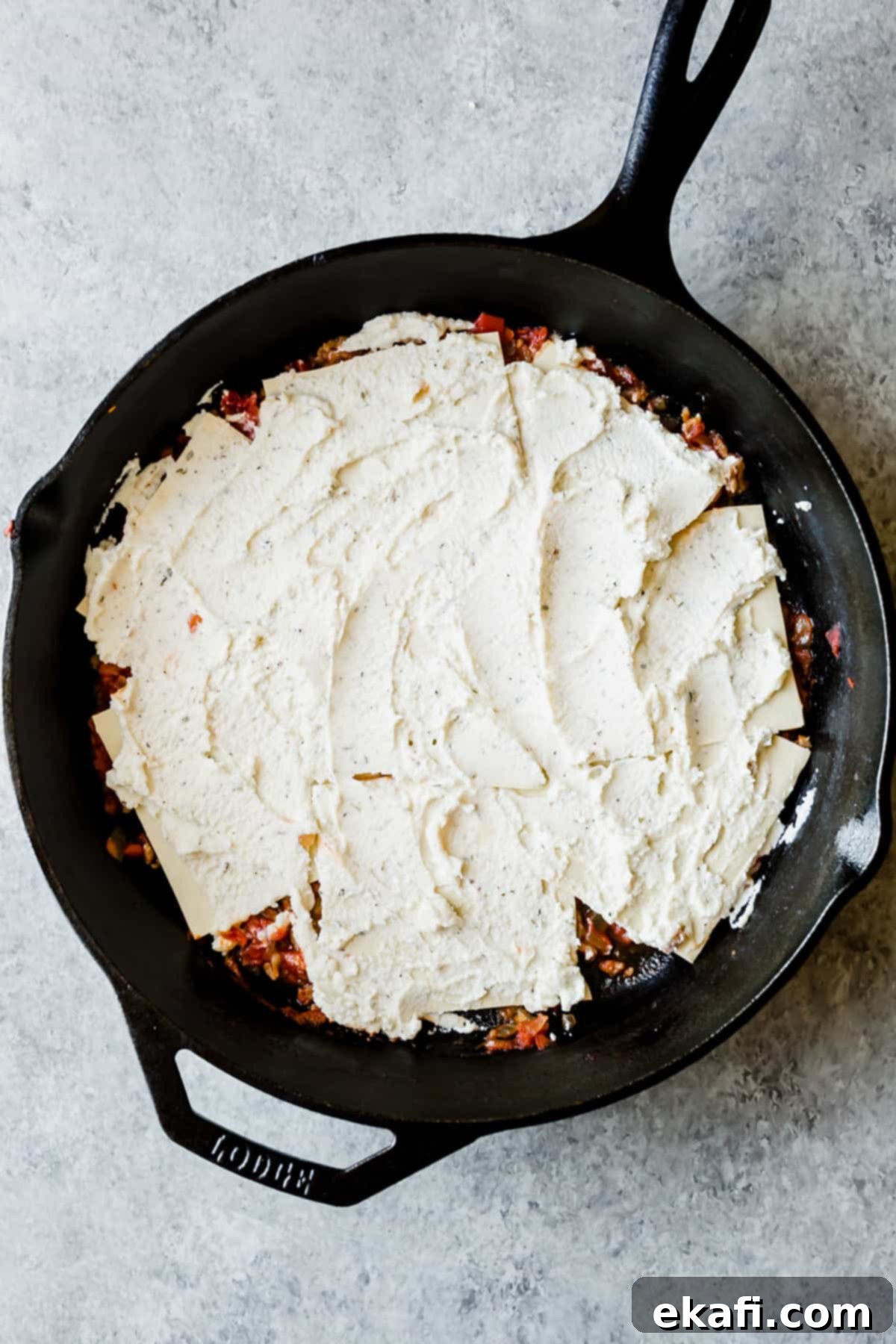

- Bake to Golden Perfection. Place the assembled skillet lasagna into your preheated oven at 400ºF. Bake for 30-35 minutes, or until the edges are bubbling vigorously, and the cheese on top has melted and turned a beautiful golden brown. The internal temperature should be heated through. Carefully remove the skillet from the oven (remembering that cast iron handles get extremely hot!). Let it rest for a few minutes before serving. This allows the layers to set and makes for easier, cleaner slices. Just before serving, crown your masterpiece with a generous sprinkle of fresh basil for a burst of color and aromatic freshness.
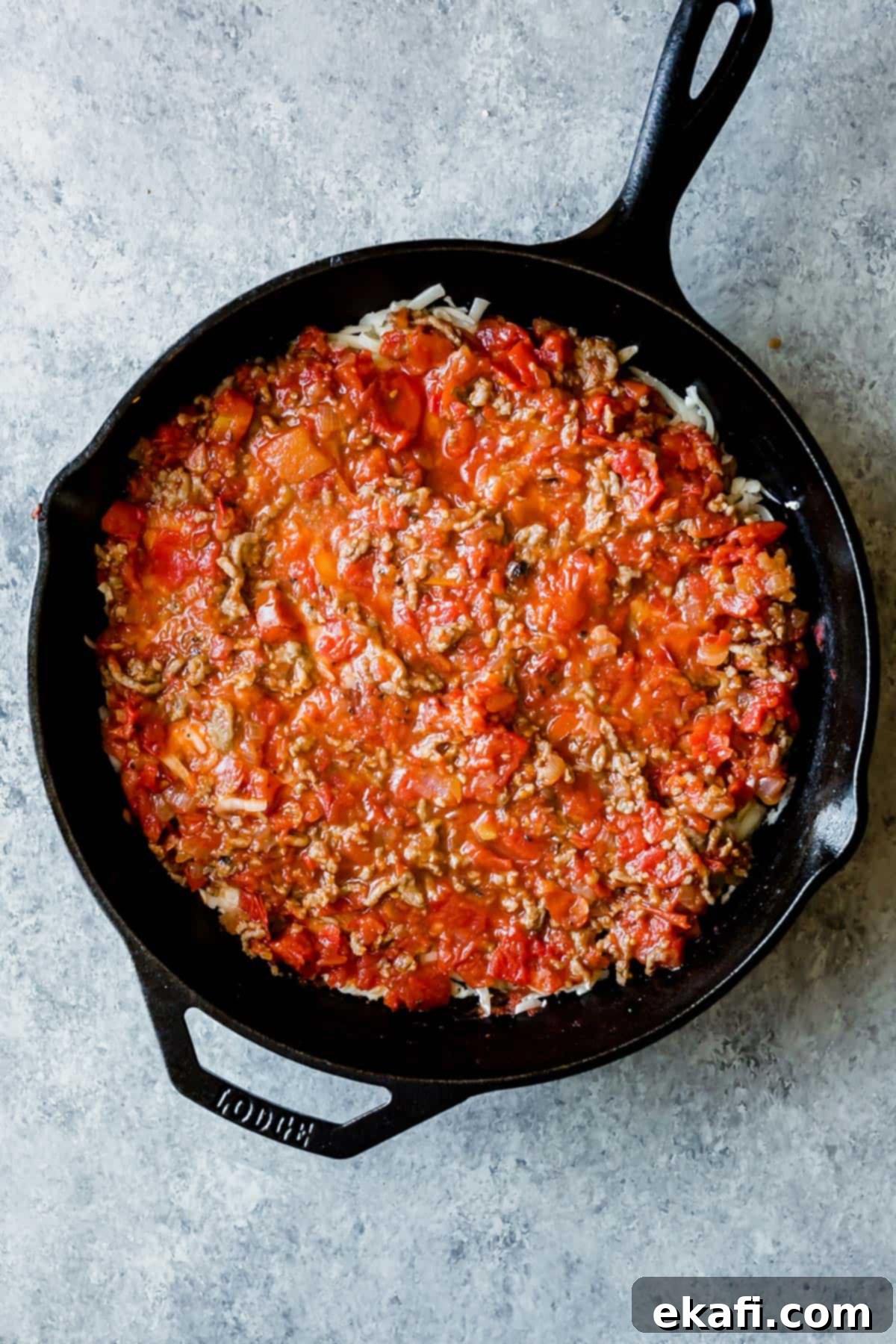
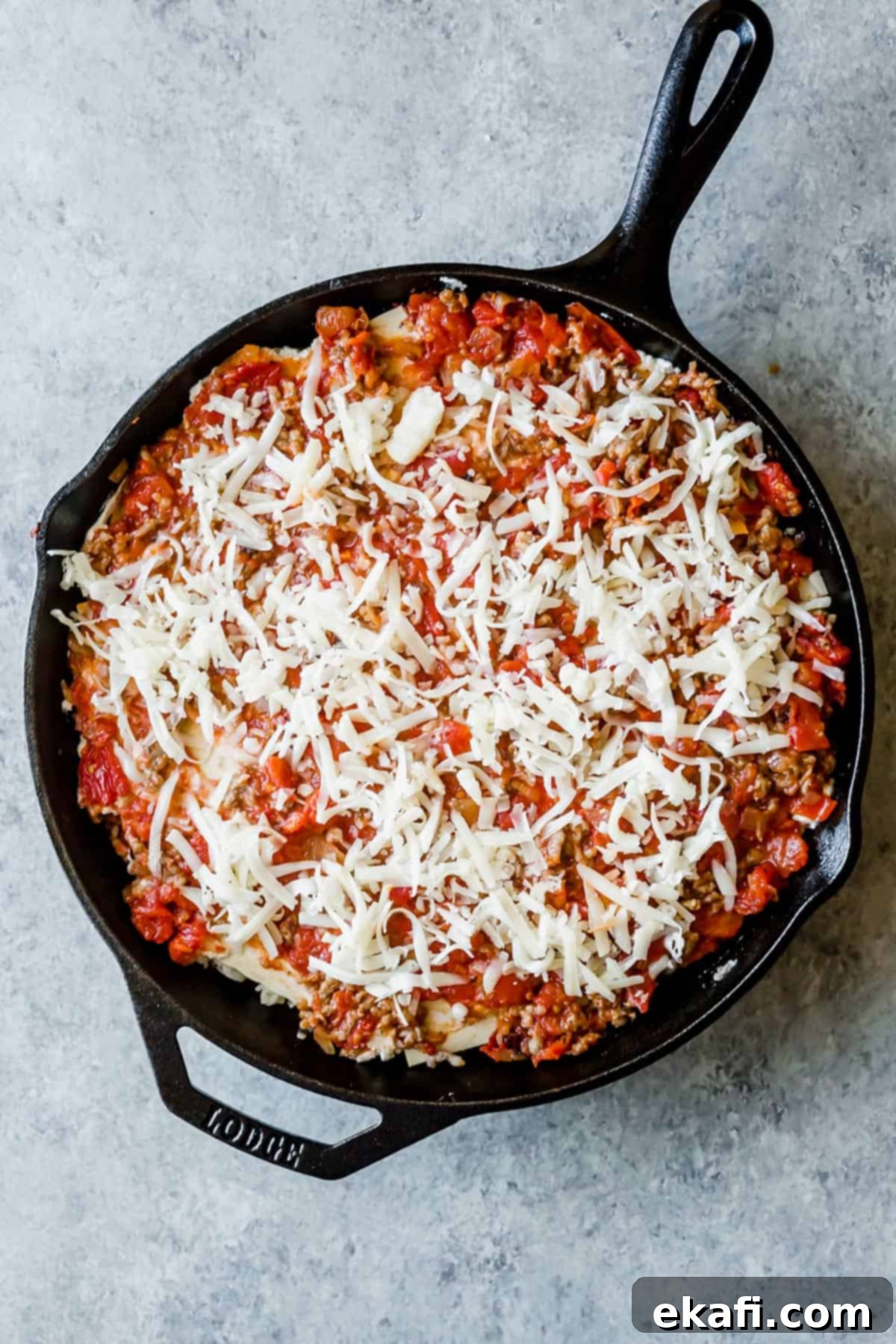
Expert Tips for Your Best Cast Iron Lasagna
Achieving the perfect cast iron lasagna is easy with a few simple tricks. For those who love a bit of *major heat* in their dishes, you have a couple of options: either increase the amount of red pepper flakes specified in the recipe, or opt for a hot Italian sausage instead of the sweet variety I used. While the sausage cooks, be diligent in breaking it up with your wooden spoon. This ensures you get nice, small, evenly cooked chunks of meat in every bite, distributing flavor beautifully throughout your ragu. Another crucial tip: once the lasagna is out of the oven, let it rest for 10-15 minutes. This allows the layers to settle and makes for cleaner, more defined slices when serving. Don’t rush it!
Make Ahead, Storing, and Freezing Your Skillet Lasagna
This cast iron lasagna recipe is wonderfully versatile for meal prep. If you plan to make it ahead of time, assemble the lasagna as instructed but do not bake it. Store the unbaked skillet lasagna, tightly covered with foil or an oven-safe lid, in the refrigerator for a few hours or up to one full day. When ready to bake, follow the recipe instructions for oven temperature and time. Keep in mind that the no-boil lasagna noodles will have had more time to soak up the liquid from the sauce while resting in the fridge, so they may be slightly softer in texture upon baking, which many people prefer!
Important Note for Cast Iron Safety: Cast iron skillets require careful temperature management to prevent damage. Never transfer a cold cast iron skillet directly from the freezer or refrigerator into a scorching hot oven, or vice versa. The abrupt and dramatic change in temperature can cause the enamel to crack or, in extreme cases, the cast iron itself to warp or shatter. Always allow your skillet to come to room temperature gradually before placing it into a hot oven or storing it in a cold environment. Alternatively, you can place the cold cast iron skillet into a cold oven and let them both preheat together, minimizing thermal shock.
For freezing, I generally recommend against freezing the lasagna directly in the cast iron skillet. The skillet’s bulkiness makes it difficult to store airtight, and it takes up significant freezer space. Instead, once your unbaked or baked lasagna has cooled completely, carefully remove it from the skillet. You can cut it into individual portions or larger blocks. Store these portions in an airtight freezer-safe container or tightly wrapped in plastic wrap and then foil to prevent freezer burn. Label with the date. Frozen lasagna can be stored for up to 2-3 months. To reheat, thaw overnight in the refrigerator (if frozen unbaked, bake as directed; if frozen baked, reheat in a preheated oven until warmed through) or reheat directly from frozen at a lower temperature until heated through. Baked skillet lasagna can be stored covered in the fridge for 3-5 days; reheat in the oven or microwave.
Frequently Asked Questions About Cast Iron Lasagna
The primary difference between no-boil and regular lasagna noodles is that no-boil noodles are par-cooked and dehydrated, meaning they are much thinner and designed to absorb liquid quickly. If you choose to use regular lasagna noodles in this cast iron recipe, you’ll need to make a significant adjustment: you will likely need to pre-boil them according to package directions before layering, or increase the amount of sauce considerably to ensure there’s enough liquid for them to fully cook and soften during baking. Without sufficient liquid, regular noodles baked dry may remain tough or undercooked.
No, the base recipe for this cast iron lasagna is not inherently spicy. It uses sweet Italian sausage and a modest amount of red pepper flakes, which contributes more to overall flavor depth than heat. However, if you’re craving a spicier kick, you absolutely can customize it! I recommend using hot Italian sausage for the ragu and/or doubling or even tripling the amount of red pepper flakes to suit your personal heat preference.
While the herbed ricotta mixture in this recipe is truly exceptional and highly recommended, a common and effective substitute for ricotta in lasagna is cottage cheese. If you’re using cottage cheese, opt for a small-curd variety and consider draining any excess liquid to prevent your lasagna from becoming watery. Be aware that while cottage cheese will provide a creamy element, the texture will be different (more distinct curds unless blended smooth) and the flavor will be slightly tangier than ricotta. Other less common substitutes include a blend of cream cheese and milk/sour cream, or even a thick béchamel sauce for a different style of creaminess.
There are several excellent reasons why using a cast iron skillet elevates this lasagna to another level! Firstly, cast iron boasts incredible heat retention and distributes heat very evenly across its surface. This means your lasagna cooks uniformly, from the edges to the center, and develops that coveted crispy, golden-brown crust on the bottom and sides – something a glass or ceramic baking dish can’t quite replicate. Secondly, cast iron is incredibly durable; with proper care, it can truly last a lifetime, becoming a cherished family heirloom. Its ability to go from stovetop to oven seamlessly means you can cook your ragu and bake the lasagna all in one pan, drastically reducing cleanup. Plus, a well-seasoned cast iron pan develops a natural non-stick surface over time, making serving and cleanup even easier. Just remember to always use oven mitts when handling cast iron, as the handle gets just as hot as the pan itself!
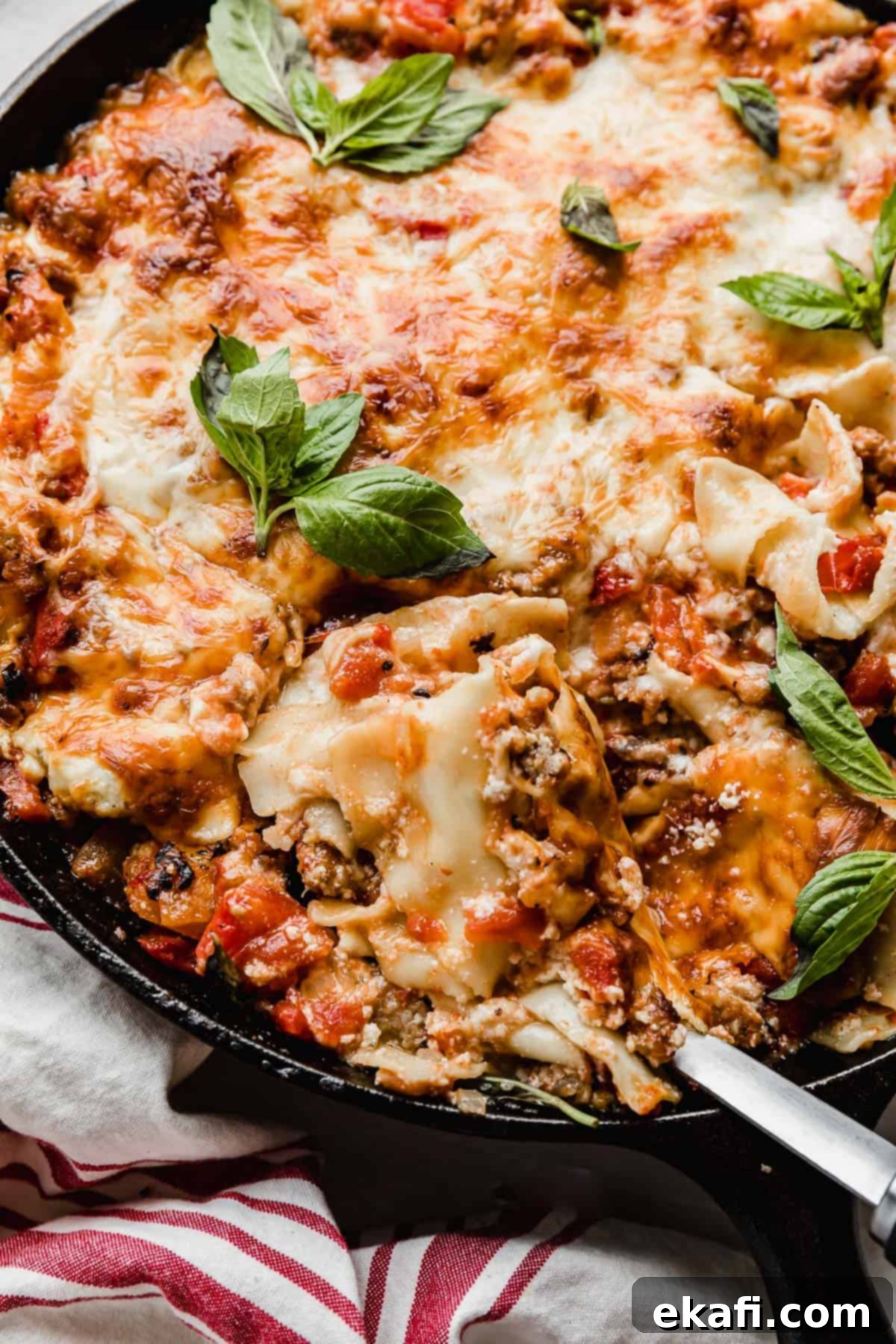
More Incredible Skillet Recipes to Try
If you’ve fallen in love with the convenience and delicious results of cooking in a cast iron skillet, you’re in for a treat! This versatile pan can tackle a wide array of dishes, from weeknight dinners to impressive weekend meals. Here are some more fantastic skillet recipes from our collection that you’re sure to enjoy, offering varied flavors and cooking styles perfect for your trusty cast iron:
- Curry Chicken and Rice
- Lemon Honey Glazed Salmon
- Creamy Tuscan Chicken
- Cast Iron Chicken Pot Pie
Did you make this recipe? We’d absolutely love to hear about your experience! Click here to share your rating and review, or simply scroll down past the recipe card to leave your feedback. Your insights help other home cooks discover and enjoy these recipes!
Stay connected and get the latest updates, recipe inspiration, and behind-the-scenes glimpses by following us on Instagram, joining our community on Facebook, and exploring our curated boards on Pinterest.
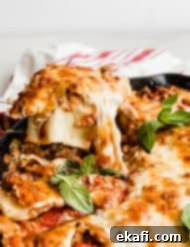
Print
SaveSaved!
Review
Cast Iron Lasagna
Ingredients
- 3 14.5 oz cans fire roasted diced tomatoes
- 2 tablespoons olive oil
- 2 cups yellow onion – finely chopped (about 1 large yellow onion)
- 3 garlic cloves – minced
- 1/4 teaspoon red pepper flakes
- 1 pound sweet Italian sausage – casings removed
- 15 oz ricotta – (425 grams)
- 1 egg yolk
- 1/4 teaspoon dried thyme
- 1/2 teaspoon dried oregano
- salt – to taste
- pepper – to taste
- 2 1/2 cups mozzarella – shredded (a little more than 8 oz)
- 1/3 cup freshly grated parmesan cheese
- 12 no boil lasagna noodles – broken in half
- 2 tablespoons fresh basil – chopped
Instructions
-
Place oven rack to the middle position. Preheat oven to 400°F.
-
Place a 12-inch cast iron skillet over medium heat. Add the olive oil. Once the olive oil is shimmering add the onion and cook until lightly browned, about 6-7 minutes. Add the garlic and red pepper flakes. Add the sausage to the onions. Using a wooden spoon break the sausage up into bite size pieces. Cook until no longer pink, about 6 minutes.
-
Add the fire roasted tomatoes to the sausage and onion. Cook over medium-low heat for 5 minutes. Transfer to a bowl.
-
In a separate medium size bowl, add the ricotta, egg yolk, thyme, oregano, and salt and pepper to taste. Stir to combine.
-
In a 3rd bowl combine the shredded mozzarella and parmesan.
-
In the bottom of the empty skillet spread 1 cup of sauce. Add 7 noodle halves around the edge of the skillet and 1 noodle half in the middle. Add 1/3 of the ricotta mixture over the noodles (spread evenly over the noodles), then top with ¼ of the mozzarella cheese mixture over the ricotta. Add 1/3 of the remaining sauce over the mozzarella. Repeat this layering process two more times. Starting with the noodles and ending with the sauce. Sprinkle the remaining mozzarella cheese mixture over top. (See blog post for pictures to illustrate the process).
-
Transfer the skillet to the oven and bake for 30-35 minutes, or until the edges are bubbling and the cheese is slightly golden brown.
-
Remove from the oven, top with chopped fresh basil and serve.
Notes
If freezing, freeze prior to baking. Make sure the skillet is completely covered and do not transfer a hot cast iron skillet into the fridge or freezer. The dramatic change in temperature can make the cast iron crack. Keep that in mind if you are transferring from the fridge or freezer to the oven. Be sure to let the cast iron skillet come to room temperature before putting in a hot oven OR let the cast iron heat up with the oven.
Use hot Italian sausage for more heat.
Nutrition
This recipe was originally published on Nov. 2, 2018. It was republished on Jan. 10, 2022, to include additional information and photos. This version has been further updated for enhanced clarity, SEO optimization, and expanded content.
